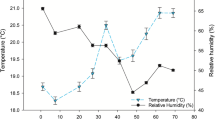Abstract
Peramine and ergovaline have ecological and economical significance because they possess insect and/or mammalian toxicity properties. The relationship between these endophytically derived alkaloids in tall fescue (Festuca arundinacea Schreb.) is unknown. Seasonal and plant tissue effects on the concentration of peramine and ergovaline was investigated in field and greenhouse experiments. The relationship between the alkaloids and the regulatory effects of endophyte and plant on their content were investigated among progeny of reciprocal crosses between high- and low-ergovaline and peramine plant-endophyte combinations. Variation in peramine concentration ranged from 750 to 1742 µg/kg in greenhouse-grown plants, and there was no seasonal trend in peramine content. There was a correlation (r=0.69) between peramine and ergovaline content among leaf tissues of field-grown plants, but there was no correlation between the alkaloids in the culm (r=0.20) or panicle (r=0.17) tissues. Mean leaf ergovaline concentration of progeny derived from the low-ergovaline parent (163 µg/kg) was less than the midparent value (228 µg/kg), but mean of progeny from the high-ergovaline parent was not different from the mid-parent value. Ranges within each progeny set were approximately double their mean. Mean leaf peramine concentrations of the progeny sets were similar to the mid-parent value (3354 µg/kg) but ranges were from 1716 to 8753 µg/kg. There was no correlation between leaf peramine and ergovaline (r=0.01). These data suggest that endophytically produced alkaloids are independently regulated and are controlled by both plant and endophyte genotype.
Similar content being viewed by others
References
Agee, C.S., andHill, N.S. 1994. Ergovaline variability inAcremonium-infected tall fescue due to environment and plant genotype.Crop Sci. 34:221–226.
Bacon, C.W. 1988. Procedure for isolating the endophyte from tall fescue and screening isolates for ergot alkaloids.Appl. Environ. Microbiol. 54:2615–2618.
Bacon, C.W., Porter, J.K., Robbins J.D., andLuttrell, E.S. 1977.Epichloe typhina from tall fescue grasses.Appl. Environ. Microbiol. 34:576–581.
Belesky, D.P., Stringer, D.C., andPlattner, R.D. 1989. The influence of endophyte and water regime upon tall fescue accessions: II. Pyrrolizidine and ergopeptine alkaloids.Ann. Bot. 63:343–349.
Brimble, M.A., andRowan, D.D. 1990. Synthesis of the insect feeding deterrent peramine via Michael addition of a pyrrole anion to a nitroalkene.J. Chem. Soc. Perkin Trans. 1:311–314.
Bush, L.P., Cornelius, P.L., Buckner, R.C., Varney, D.R., Chapman, R.A., Burris, P.B., Kennedy, C.W., Jones, T.A., andSaunders, M.J. 1982. Association ofN-acetyl and N-formyl loline withEpichloe typhina in tall fescue.Crop Sci. 22:941–943.
Clay, K. 1988. Fungal endophytes of grasses: A defensive mutualism between plants and fungi.Ecology 69:10–16.
Cress W.A., Chayet, L.T., andRilling, H.C. 1981. Crystallization and partial characterization of dimethylallyl pyrophosphate:L-Tryptophan dimethylallyl transferase fromClaviceps sp. SD58.J. Chem. 256(10):10917–10923.
Duman, D.J. 1988. Total synthesis of peramine.J. Org. Chem. 53:4650–4653.
Elmi, A.A., West, C.P., andTurner, K.E. 1989. Endophyte effect on leaf osmotic adjustments in tall fescue.Agron. Abst. 81:111.
Hill, N.S. 1993. Physiology of plant-endophyte interactions: Implications and use of endophytes in plant breeding, pp. 161–170,in D. E. Hume, G. C. M. Latch, and H. S. Easton (eds.). Proceedings of the Second International Symposium ofAcremonium/Grass Interactions: Plenary Papers. AgResearch, Grasslands Research Center, Palmerston North, New Zeland. February 3–4.
Hill, N.S., Parrot, W.A., andPope, D.D. 1991. Ergopeptine alkaloid production by endophytes in a common tall fescue genotype.Crop Sci. 31:1545–1547.
Hill, N.S., Rottinghaus, G.E., Agee, C.S., andSchultz, L.M. 1993. Simplified sample preparation for HPLC analysis of ergovaline in tall fescue.Crop Sci. 33:331–333.
Hill, N.S., Thompson, F.N., Dawe, D.L., andStuedemann, J.A. 1994. Antibody binding of circulating ergopeptine alkaloids in cattle grazing tall fescue.Am. J. Vet. Res. 55:419–424.
Hoveland, C.S., Schmidt, S.P., King, C.C., Odom, J.W., Clark, E.M., Mcguire, J.A., Smith, L.A., Grimes, H.W., andHoliman, J.L. 1983. Steer performance and association ofAcremonium coenophialum fungal endophyte on tall fescue pasture.Agron. J. 75:821–824.
Lee, S.L., Floss, H.G., andHeinstein, P. 1976. Purification and properties of dimethylallylphyrophosphate: Tryptophan dimethylallyl transferase, the first enzyme of ergot alkaloid biosynthesis inClaviceps sp. SD58.Arch. Biochem. Biophys. 177:84–94.
Lyons, P.C., Plattner, R.D., andBacon, C.W. 1986. Occurrence of peptide and clavine ergot alkaloids in tall fescue.Science 232:487–489.
Read, J.C., andCamp, B.J. 1986. The effect of the fungal endophyteAcremonium coenophialum in tall fescue on animal performance, toxicity, and stand maintenance.Agron. J. 78:848–850.
Rowan, D.D., andGaynor, D.L. Isolation of feeding deterrents against Argentine stem weevil from ryegrass infected with the endophyteAcremonium loliae.J. Chem. Ecol. 12:647–658.
Rowan, D.D., Hunt, M.B. andGaynor, D.L. 1986. Peramine, a novel insect feeding deterrent from ryegrass infected with the endophyteAcremonium loliae.J. Chem. Soc. Chem. Commun. 1986:935–936.
Siegel, M.R., Latch, G.C.M., Bush, L.P., Fannin, F.F., Rowen, D.D., Tapper, B.A., Bacon, C.W., andJohnson, M.C. 1990. Fungal endophyte-infected grasses: Alkaloid accumulation and aphid response.J. Chem. Ecol. 16:3301–3315.
Tapper, B.A. 1993. A New Zealand perspective on endophyte metabolites, pp. 89–93,in D. E. Hume, G. C. M. Latch, and H. S. Easton (eds.). Proceedings of the Second International Symposium onAcremonium/Grass Interactions: Plenary Papers. AgResearch Grasslands. Palmerston North, New Zeland.
Tapper, B.A., Rowan, D.D., andLatch, G.C.M. 1989. Detection and measurement of the alkaloid peramine in endophyte-infected grasses.J. Chromatogr. 463:133–138.
Author information
Authors and Affiliations
Rights and permissions
About this article
Cite this article
Roylance, J.T., Hill, N.S. & Agee, C.S. Ergovaline and peramine production in endophyte-infected tall fescue: Independent regulation and effects of plant and endophyte genotype. J Chem Ecol 20, 2171–2183 (1994). https://doi.org/10.1007/BF02033195
Received:
Accepted:
Issue Date:
DOI: https://doi.org/10.1007/BF02033195




